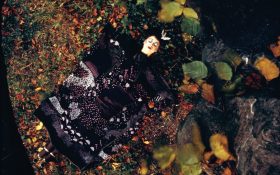Marie Laurencin lives in Aberdeen. Head up Belmont Street, keep going across the road into the Art Gallery, go upstairs and turn left, then right. There she is, in the left hand corner. And how spectacular she is too. La Guitare was painted in 1936 and bought by the gallery in 1937. How clever the gallery people were. They even snaffled a lithograph of Promenade a year or so later.
But La Guitare is one of her archetypal portraits – lots of chiffon, flowers and flesh in pastel pinks, greens and blues – from her most productive and mature period and is still in what I take to be its original gold-leaf encrusted frame, exactly like those in the Orangerie de la Louvre.
Aberdeen Art Gallery shares something else with the Orangerie: Monet and Renoir. But there are numerous other delights from just about every ‘name’ from the last 200 years. The walls are full of Peploes, Sickerts and Cadells as well a fabulous portrait by Bessie MacNicol, “whose work anticipated those colourists”, it says here.
At every turn there’s something arresting: Picasso sitting next to Chagall, Matisse alongside Signac. Turner watercolours, bronzes by Degas and Rodin, a Bacon pope, a Gilbert and George self-portrait. Loads more. It’s an excellent collection which is thoughtfully presented and the city is, no doubt, very proud of it.
Laurencin wasn’t exactly a prolific artist, so Aberdeen are doing very well indeed to have two. Jean-Pierre de Beaumarchais, writing in 1983, drew attention to Laurencin’s real originality as lying in “her talent as a colourist, marked by the use of very subtle tones, and in her sometimes affected naïveté and love of graceful adolescent faces”.
Aberdeen’s painting has all of that and is a splendid counterpoint to all those Peploes, Sickerts and more in the adjoining rooms. Imagine how lucky I feel to own one of her limited edition prints. Sounds better than it is, because there were just over a hundred and one thousand of them, created for the Mouton Rothschild label of 1948. Mine’s in bad order, but then it is even older than me, and if I’d been kept in a damp cellar for thirty odd years I too would probably be a little bit flaky.
Sadly, Baron Philippe was prone to “improving” the artwork for his labels. He replaced her light green wash with gold, then cropped the rectangular image into a lozenge shape. He did something similar to Dali’s drawing for the ‘58 label. Sacrilege. My label sits in a cupboard, wrapped with its empty bottle in cellophane. I’d do a swap with AAG. On the other hand, it has occurred to me that if I ever fall on hard times the Musée Marie Laurencin in Tokyo (of all places) might be persuaded to get into an e-Bay bidding war for it. True, they have what amounts to a world monopoly with 500 items already, but that only proves their fanaticism! Even MoMA only have five.
Although rich and dazzling, Aberdeen’s collection is not faultless, so the Art Institute of Chicago stays in top spot for now. I should explain. I was once directed by gallery staff to a piece by John Lambie (he of the Turner Prize shortlist) called Head and Shoulders with Conditioner. This consists of 189 old LP covers, arranged in 9 rows of 21 to fill a wall, each cover being a portrait with all the titles and text obliterated by black carpet tape. It is of course nothing but a very large pun and owes more to redtop newspaper headlines than art.
Or, according to the gallery, “it combines his two loves, music and colour, in a humorous and beguiling way”. Yeah, right. I also found one of my old sleeping bags there, thrown on the floor. It was the exact model that we bought two of in Glasgow Trongate back in 1972 and only recently threw out. So it was a surprise to find that somebody had rescued it, cast it in bronze and painted it in its original colours. We don’t know why.
Being an east coast city, Aberdeen is blighted by the haars that roll in from the North Sea in spring and summer. It also gets more than its fair share of biting winds and blizzards at other times. The southern extent of Arctic pack ice is visible just off-shore from the Fun Beach, accessed by way of Beach Boulevard (there are no trees within seven miles). Last time I was in Patagonian Court I actually had to negotiate ice floes. OK, I may be exaggerating slightly, but it’s all in a good cause.
When in Aberdeen, go to the Art Gallery. It’s inside, it’s warm and it’s mostly wonderful.
Aberdeen Art Gallery is open Monday – Saturday 10am-5pm, Sunday 2-5pm, at Schoolhill, Aberdeen, AB10 1FQ.
.




